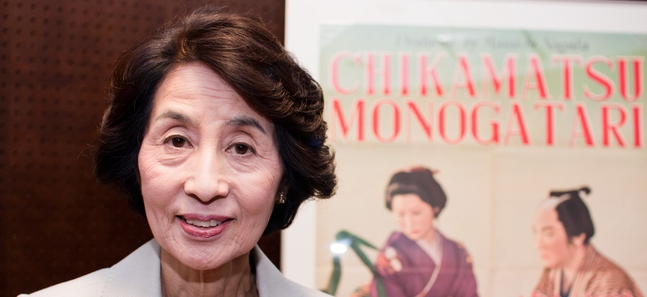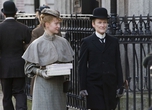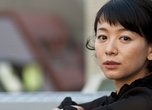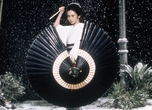Kyoko Kagawa: the interview
The veteran actress looks back on an illustrious career in cinema

Posted: Tue Oct 04 2011
Kyoko Kagawa’s filmography would make her the envy of almost any actress. The 79-year-old has worked with many of the greats of Japanese cinema, including Yasujiro Ozu (with whom she made Tokyo Story), Kenji Mizoguchi (A Story from Chikamatsu; Sansho The Bailiff) and Akira Kurosawa (The Lower Depths; Red Beard and others). Though she is no longer the ubiquitous screen presence she was in the ’50s and ’60s, she has remained quietly active in TV and cinema, and was this year given an award by the International Federation of Film Archives (FIAF) for her contribution to film preservation – placing her in the company of previous winners including Martin Scorsese and Ingmar Bergman.
Kagawa is being honoured with a special retrospective at this year’s Tokyo International Film Festival, which will include a freshly restored print of A Story from Chikamatsu. She gave a press conference at the Foreign Correspondent’s Club of Japan to mark the occasion, and then kindly agreed to a sit-down interview with Time Out.
Which actor or director do you feel has had the greatest influence on you?
There have been so many! (Laughs) One of the actresses who had the great influence on me was Kiyo Tanaka, whom I worked with on the film Okaasan. She was very approachable off-camera, but when she was in front of the camera she embodied the role so well that you couldn’t even talk to her. I remember wishing that I could be an actress like that one day. There are others who have influenced me as well, like Hideko Takamine and Setsuko Hara. They didn’t really teach me much on set, but just looking at the way they worked and the way they lived their lives was a very valuable lesson.
And which director left the most abiding impression?
The one that stands out most for me is A Story from Chikamatsu. Mizoguchi wouldn’t give us much direction on set: when we arrived he would just say, ‘Okay, go ahead, do it’ and that was it. It would be test after test after test until we finally got it right, so that was very tough. But I do feel that, by doing this, Mizoguchi taught me the basics of what acting actually is. Ozu was quite the opposite: he was very meticulous and detailed in his direction. He had his camera at a low angle on set and he would direct the actors and actresses to sit in very specific places. He had a very different style.
As for Kurosawa, he was a lot like Mizoguchi. They say that Kurosawa didn’t depict women very often in his films, so as an actress I found that to be very difficult – how to approach my characters, I mean. Again, he wouldn’t explain a lot: for example, in High and Low, I played a parent whose child was kidnapped, and my husband was played by Toshiro Mifune. I would sit there in silence, reacting to what other people said: if Mifune said something, I would have to act off that; if my child said something, I would have to act off that. I was in a constant state of tension, just thinking, ‘I have to react, I have to react.’ And the first person who taught me that was Mizoguchi. ‘Are you acting off each other?’ he would often say. ‘Reaction, reaction!’ When I appeared in Kurosawa’s films, I would keep reminding myself the same thing – so I think Mizoguchi left the most lasting impression on me.
Mizoguchi was known for shooting in very long takes. What was that like as an actor?
As a matter of fact, I really didn’t mind Mizoguchi’s long takes, because you could keep on acting without interrupting the flow of your emotions. I find it more difficult when a director prefers to take one shot for each gesture – that's very hard for me. With Kurosawa, he would place the camera a long way from the actors, which you’d think would give you more freedom, but in fact sometimes he would be shooting a close-up. (Laughs) That kept me on my toes.
How do you think the film world has changed since then?
I think the biggest difference is that the major studios have vanished. Japan used to have a lot of big studios: I was part of Shin-Toho, and there was also Daiei, Toho, Nikkatsu, Shochiku… These studios gave Japanese film directors the time and money they needed to make their masterpieces, but it isn’t like that any more. I went independent early on, so I had the experience of trying to make good films on a limited budget as part of an independent production. However, nowadays I think that most films are actually independent productions.
Back when I was making films, there used to be groups – there was the Ozu group, the Mizoguchi group or the Kurosawa group. Those directors would use the same crew to make their films each time. It doesn't seem like that today: today everyone can make a film, and I think there is more freedom – for better or for worse. When I was working with directors, I was young and they were so intimidating that I wasn't able to talk with them on set: all I could do was listen to what they had to say and go ‘Hai, hai...’ Nowadays, the directors and actors seem more like friends, so it will be very casual on set. ‘Hey, director!’ ‘Yeah?’ That seems very... strange to me. But I suppose that times have changed.
Of all the locations you’ve filmed at, do you have any particular favourites?
About three years after my debut, I starred in a film by Nobuo Nakagawa called Kogen no Eki yo Sayonara. It was a melodrama, where I played a nurse working at a sanatorium in the mountains. (Laughs) Two stops from Karuizawa [in Nagano Prefecture], there’s a rustic station called Shinano-Oiwake, where the platform looks straight out onto Mount Asama. My character falls in love with a man called Toshio Nomura, played by Michitaro Mizushima, but he has a fiancée so they eventually bid farewell at the station. I was 19 at the time, and I took a real fancy to that station. The air was clean up there, and the writer Tatsuo Hori had also lived in Shinano-Oiwake, so his stories made me pine for the place. When summer came each year, I would want to go, so eventually I had a small holiday home built there. (Laughs)
Why do you think Tokyo Story is still so popular overseas?
I think it has a lot of points that people can relate to, for instance concerning the family. I was playing the youngest character, and there’s a scene where she says, ‘I won’t ever become like that’– meaning, like a grown-up. I was 21 at the time, and I understood that sentiment very well. After that, I started a family and had children of my own, and I came to understand the feelings of the generation represented by the eldest son, So Yamamura, and the eldest daughter, Haruko Sugimura. They’d like to devote more time and attention to their parents, but their day-to-day lives take priority: the feeling is there, but they aren’t able to act on it. And now, I understand what it feels like for the parents themselves. That film gives people of all ages something to think about.
As an actress, do you have any advice for young people today?
I don’t usually make grand pronouncements like that, but if younger people come to me with questions, I’ll answer them. If there is one general piece of advice I can give, it would be this: there are many, many films in the past that you can learn from, so watch as many as you can. Also, be curious about the world, be curious about life. I have been an actress for over 60 years now, and I think the people I’ve met and the opportunities I’ve had have made my life so much fuller. So I would say it is important always to be curious, always to try many different things. You may think in your youth that a lot of things are a waste of time, but nothing is a waste of time. You will realise later that it proved useful to you somehow.
The Kyoko Kagawa Retrospective screens as part of the 24th Tokyo International Film Festival, Oct 22-30
Tweets
- About Us |
- Work for Time Out |
- Send us info |
- Advertising |
- Mobile edition |
- Terms & Conditions |
- Privacy policy |
- Contact Us
Copyright © 2014 Time Out Tokyo














Add your comment